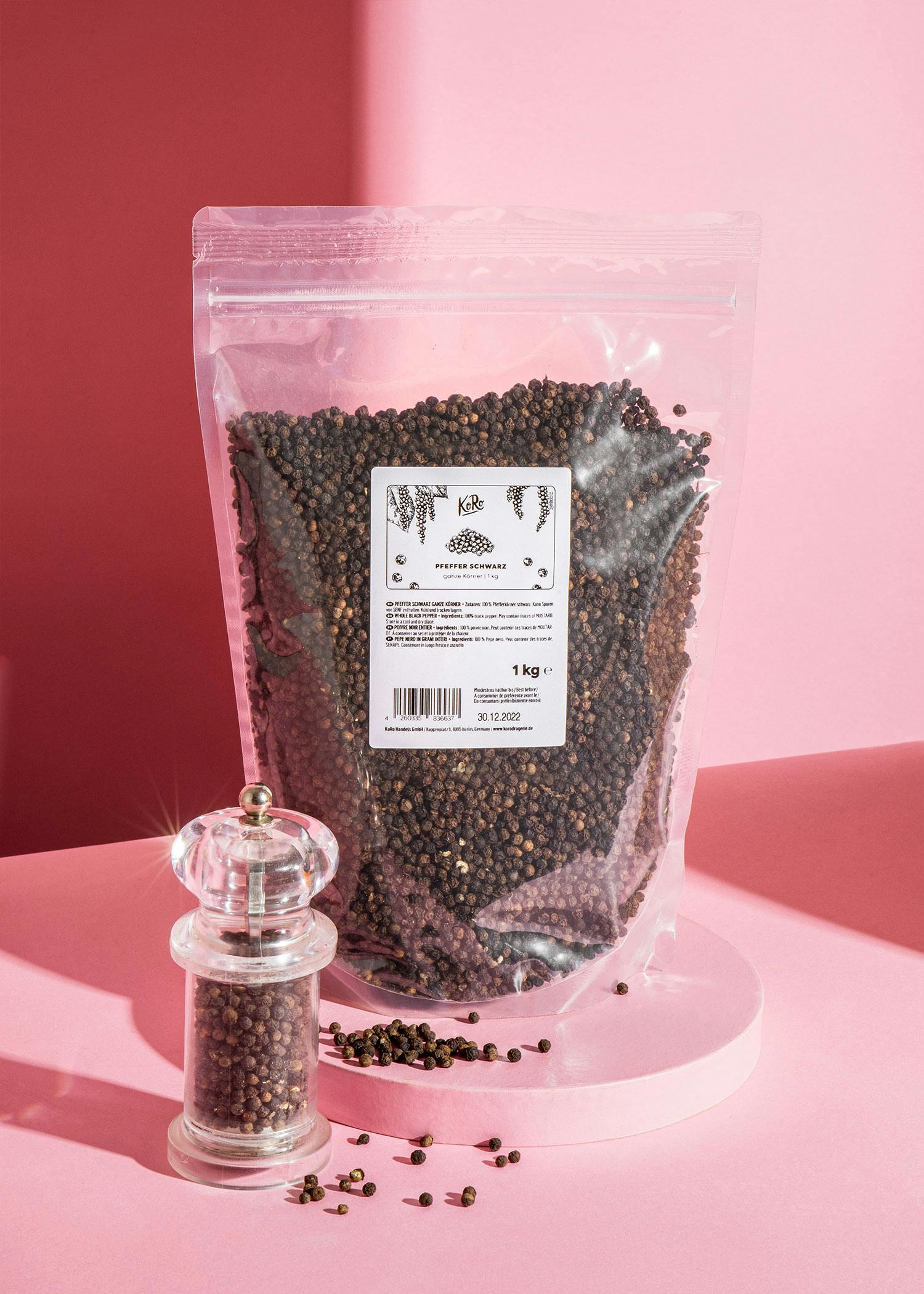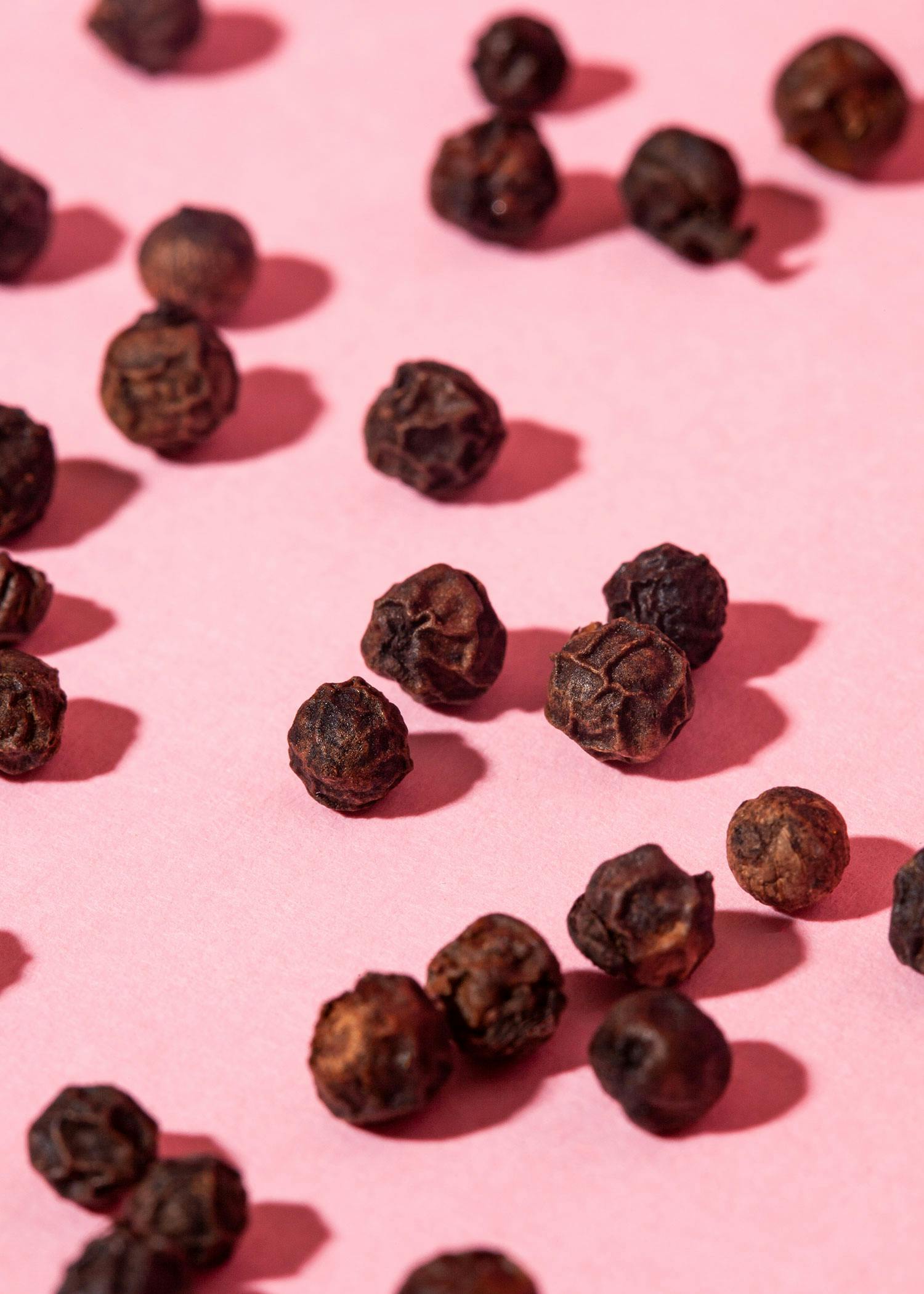Ready for a little history lesson?
Back in the days when you had to go where the pepper grew, you had to walk quite a long way. Originally, pepper only grew in India. Around 1000 years ago, it slowly spread to Indonesia, Malaysia, Vietnam and Brazil. However, as pepper still had to be transported overland to Europe in the beginning, it was so valuable at the time that it was worth its weight in gold. Nowadays, the fruit is widely available in many colors. The fruit? That's right, the peppercorns are actually the fruit of the pepper bush. And they come in four colors.
Green pepper
This pepper variety owes its green color to the early harvest. Subsequent soaking in a salt or vinegar solution prevents fermentation. As a result, the pepper retains its green color. Only then is it dried or alternatively shock-frozen. At this early stage of ripeness, the core of the pepper is still very small. However, as the spiciness is mainly in the core, it is very mild and even slightly fruity compared to black and white pepper. It goes perfectly with milder dishes where only a light pepper note is desired.
Thai curry with green pepper
You need:
- 200 g tofu
- 2 tbsp neutral oil (e.g. rapeseed oil)
- 1 onion
- 1 broccoli incl. stalk
- 1 zucchini
- 1 tin of coconut milk
- 1 tbsp soy sauce
- 2 tbsp green curry paste
- 1 tsp pickled green peppercorns
- Choice of rice or rice noodles
- 1 lime
- Possibly fresh coriander
This is how it works:
- Dice the tofu. Heat the oil in a pan, fry the tofu until crispy and set aside.
- Dice the onion, cut the broccoli including the stalk and zucchini into bite-sized pieces. Fry the onion in a deep pan, add the broccoli and zucchini. Add the curry paste and fry briefly to allow the spices to release their aroma.
- Deglaze with coconut milk and soy sauce. Add the pickled green pepper. Add water so that the vegetables are completely covered. Cook for approx. 10 mins.
- In the meantime, cook the rice or rice noodles.
- Combine the Thai curry with the chosen side dish and top with crispy tofu.
- Drizzle with lime juice and garnish with fresh coriander to taste.
Red pepper
Unlike green pepper, its red twin is made from fully ripe and unpeeled pepper fruits. As the pepper fruits do not all ripen at the same time, they have to be selected by hand. This makes the red pepper quite valuable. The fruits are then sun-dried and hand-selected again to ensure that no unripe berries are overlooked. To preserve the red color, the drying process has to be very quick. The taste is an interesting and unique combination of spicy and fruity-berry notes. This pepper is therefore not only suitable for hearty dishes, but also for fruity desserts. Whoever thought that red pepper and pink pepper berries are the same thing? Pepper berries do not come from a pepper plant, but from the chinus tree, which is most closely related to the cashew. But both are still delicious!\n\n
Fennel salad with orange and red pepper
You need:
- 1 fennel
- 1 orange
- 1 tbsp white wine vinegar
- 2 tbsp olive oil
- 1 pinch of freshly ground red pepper
- 1 pinch of salt
This is how it works:
Halve and finely slice the fennel. Peel the orange, remove the skin if possible and break into pieces.
Mix the ingredients for the dressing in a bowl, fold in the fennel and oranges.
KoRo tip: Enjoy with toasted sourdough bread!
White pepper
The fully ripe peppercorns of white pepper are removed from their skin, giving them a light beige color and thus their name. This is how it works: The ripe red berries are harvested and soaked in running water for up to 14 days. The skin then comes off through rotting. They are then peeled, dried and partially bleached in the sun. Although white pepper has a somewhat milder aroma compared to the other pepper varieties, it is also intensely hot due to the pungent piperine, which is concentrated in the peppercorn. It is always used when the focus is on the spiciness, but the aroma of the food should not be altered.
Lemon and rice soup with white pepper
You need:
- 500 ml vegetable stock
- 1 leek
- 1 clove of garlic
- 30 g rice (preferably round grain rice)
- 1 tin of white beans
- 1 lemon (including zest)
- ½ tbsp nutmeg
- 1 pinch of freshly ground white pepper
- fresh mint
- 1 tbsp olive oil + a little more for garnish
This is how it works:
- Wash the leek and cut into fine rings. Press the garlic.
- Heat the olive oil in a deep pan and sauté the leek for approx. 2 minutes, then add the garlic and sauté briefly.
- Deglaze with vegetable stock. Wash the rice and add to the pan, simmer for 15 minutes on a low heat.
- Add the spices and beans and season with lemon juice to taste.
- Chop the mint and grate the lemon zest. Garnish the soup with a dash of olive oil, mint and lemon zest and season to taste with salt and fresh white pepper.
Black pepper
The most common pepper in our country is black pepper, which comes from Brazil and Vietnam. The initially unripe, green to yellow-orange fruits only become wrinkled and black when they are dried. It not only comes close to the pungency of white pepper, but also has an intense aroma. But that is not the only reason why we have mainly opted for black pepper here. This is because it contains a certain pungent substance that triggers the release of happiness hormones in the body, which can trigger a general feeling of well-being. Its use in the kitchen? In fact, it goes well with all dishes that are also salted, but especially with dark meats, hearty stews or pasta dishes and dark sauces.
Pasta with oyster mushrooms and black pepper
You need:
- 300 g oyster mushrooms
- 1 onion
- 1 clove of garlic
- 200 g noodles
- 2 tbsp soy cream
- soy sauce
- 2 tbsp olive oil
- 1 pinch of freshly ground black pepper
- 1 tsp salt + salt for the pasta water
- Fresh parsley
This is how it works:
- Bring the water to the boil and add salt.
- Meanwhile, clean the oyster mushrooms and tear into pieces. Dice the onion and garlic. Heat the olive oil in a pan and fry the onion and garlic until translucent. Add the mushrooms until they are nice and crispy.
- Cook the pasta until al dente.
- In the meantime, deglaze the mushrooms with soy sauce, add the soy cream and add a ladle of pasta water to thicken.
- Season to taste with salt and freshly ground pepper. Drain the pasta and add to the sauce. Garnish with fresh parsley.
Why do we actually sell whole peppercorns?
The already ground pepper from the pepper shaker is better known. So why go to the trouble of grinding the grains yourself? Pepper contains volatile essential oils that evaporate much more quickly when ground. And of course we don't want that: after all, we use pepper for both its smell and its aroma. That's why we only put whole grains in the bag, just waiting to give your dishes that certain spice!

